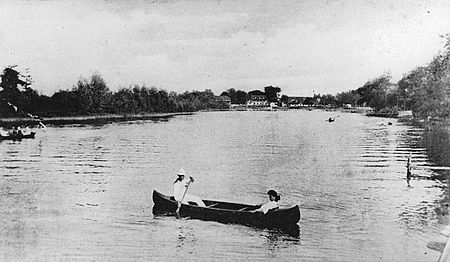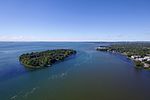Chateauguay River

The Chateauguay River (or Chateaugay River in the United States, Mohawk: Oshahrhè:’on) is a tributary of the South Shore of the St. Lawrence River, flowing in: Clinton County and Franklin County, in the Adirondacks, in New York State, in United States; the Le Haut-Saint-Laurent Regional County Municipality: crossing the municipalities of Huntingdon, Ormstown and Howick, in Montérégie, in Quebec, in Canada; the MRC of Beauharnois-Salaberry Regional County Municipality: municipality of Sainte-Martine, in Montérégie; the MRC of Roussillon Regional County Municipality: city of Mercier, in Montérégie.This valley is mainly served by the following roads: in Quebec (East side, from the mouth): boulevard Salaberry Nord, boulevard Salaberry Sud, chemin du rang Roy, chemin de la Beauce, rue Saint-Joseph, boulevard Saint-Jean-Baptiste-Ouest (route 138), Island Road, Fairview Road, Athelstan Road, Montée de Powerscour; in Quebec (West side, from the mouth): boulevard D'Youville, chemin de la Haute-Rivière, chemin du Grand-Marais, chemin du rang Dubuc, chemin du rang Touchette, chemin du rang Laberge, chemin de la Rivière-Châteauguay, rue Lambton, route 138A, route 138 (rue Châteauguay), ascent Gillmore, ascent Shearer; in New York State (East side, from the border): Simms Road, Chasm Road, Commons Road, Lake Street (NY 374); in New York State (west side, from the border): Lewis Road, Cemetery Road, Healy Road, Chase Road, Merrill Road, Lake Road, Narrows Road, Gadway Road.This territory, located in the Montérégie administrative region, is made up of twenty-eight (28) watersheds that flow into the St. Lawrence River and includes thirty-nine (39) municipalities and cities. The Châteauguay River watershed has a relatively dense population of approximately 215,000 people who place significant stress on the region's water resources, 41% of which rely on groundwater as a source of supply. The river surface is generally frozen from mid-December to the end of March. Safe circulation on the ice is generally done from the end of December to the beginning of March. The water level of the river varies with the seasons and the precipitation.
Excerpt from the Wikipedia article Chateauguay River (License: CC BY-SA 3.0, Authors, Images).Chateauguay River
Chemin du Bord-de-l'Eau,
Geographical coordinates (GPS) Address Nearby Places Show on map
Geographical coordinates (GPS)
| Latitude | Longitude |
|---|---|
| N 45.401 ° | E -73.752 ° |
Address
Chemin du Bord-de-l'Eau 167
J6J 1Z9
Quebec, Canada
Open on Google Maps







